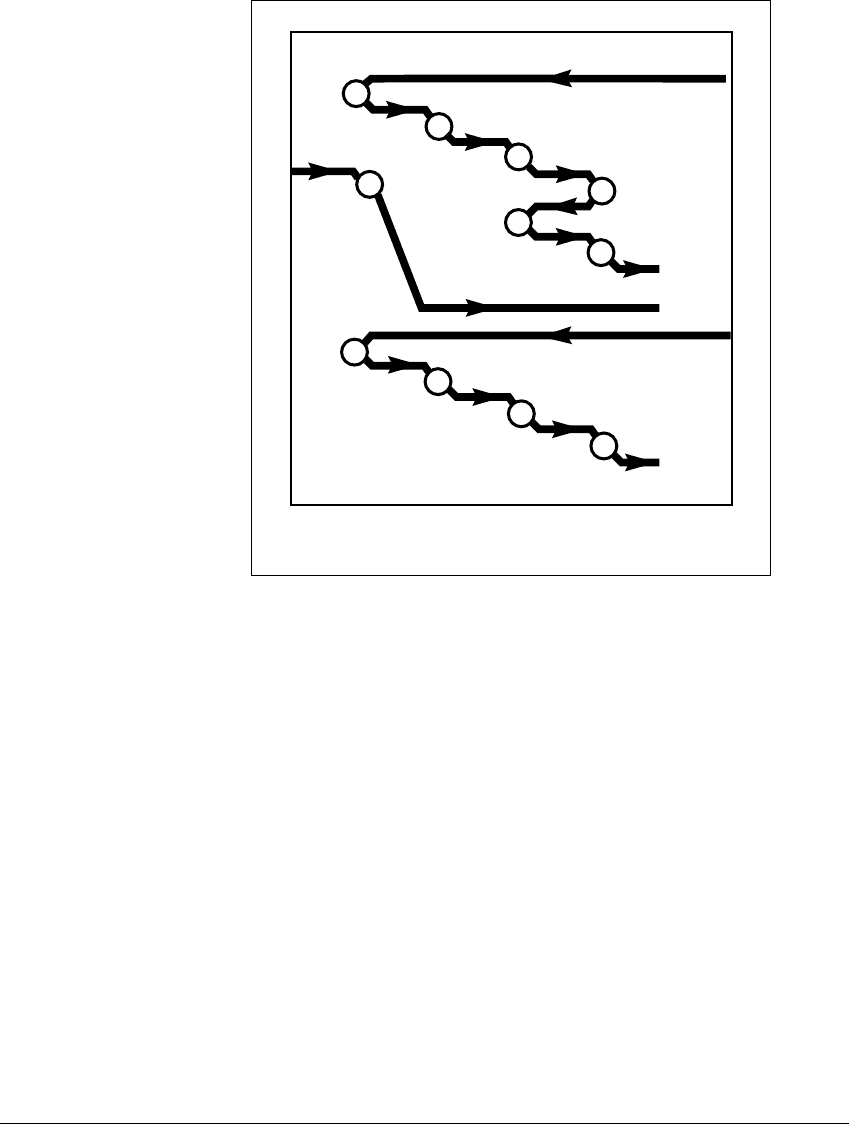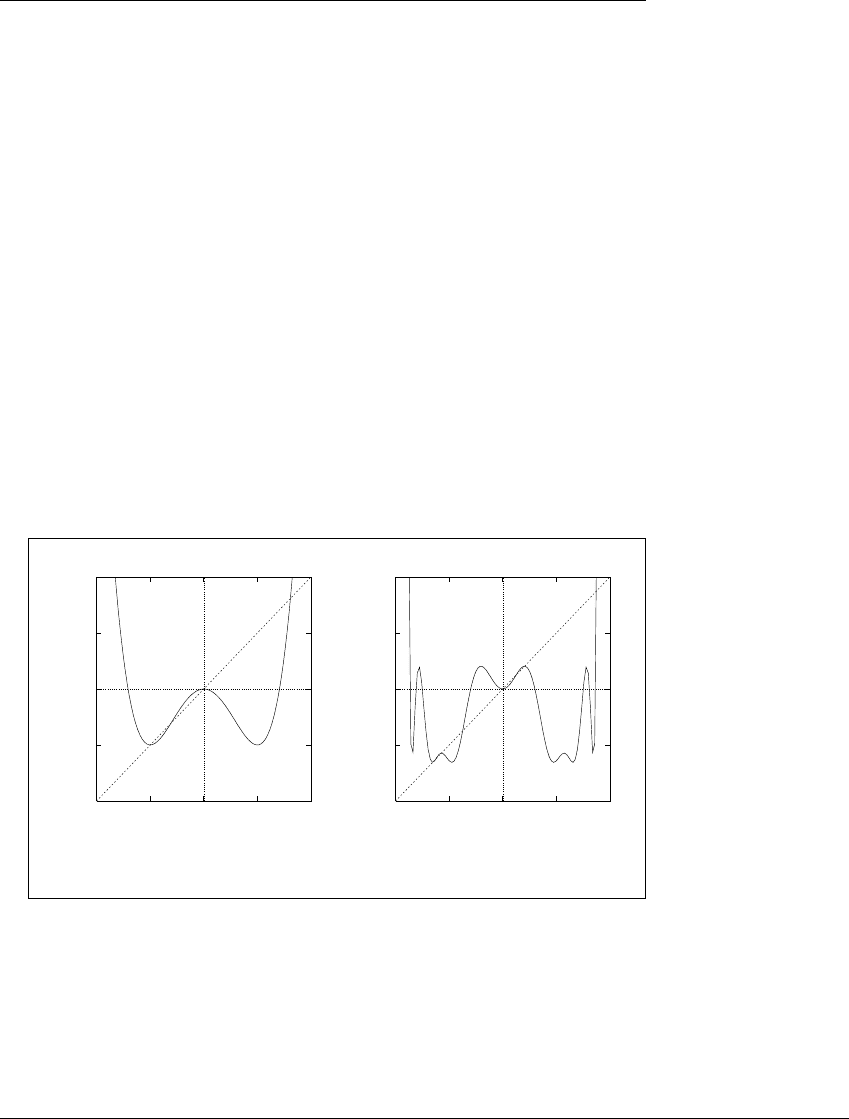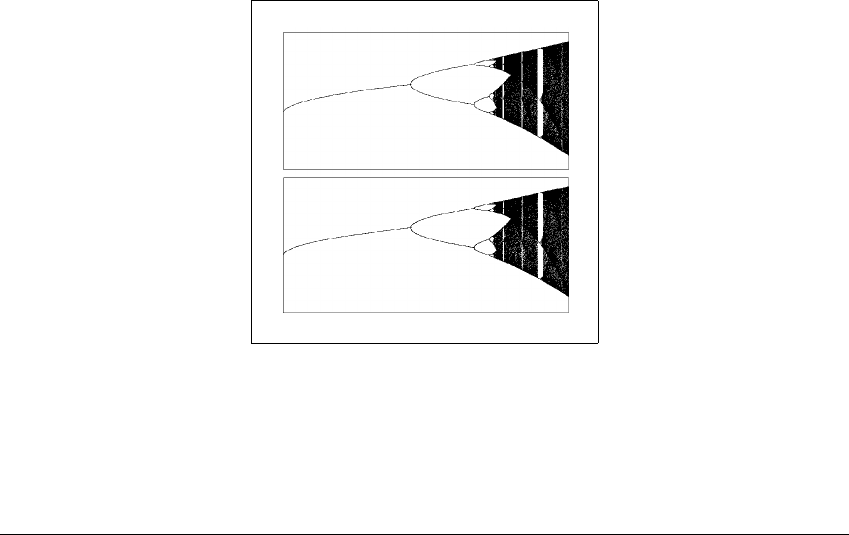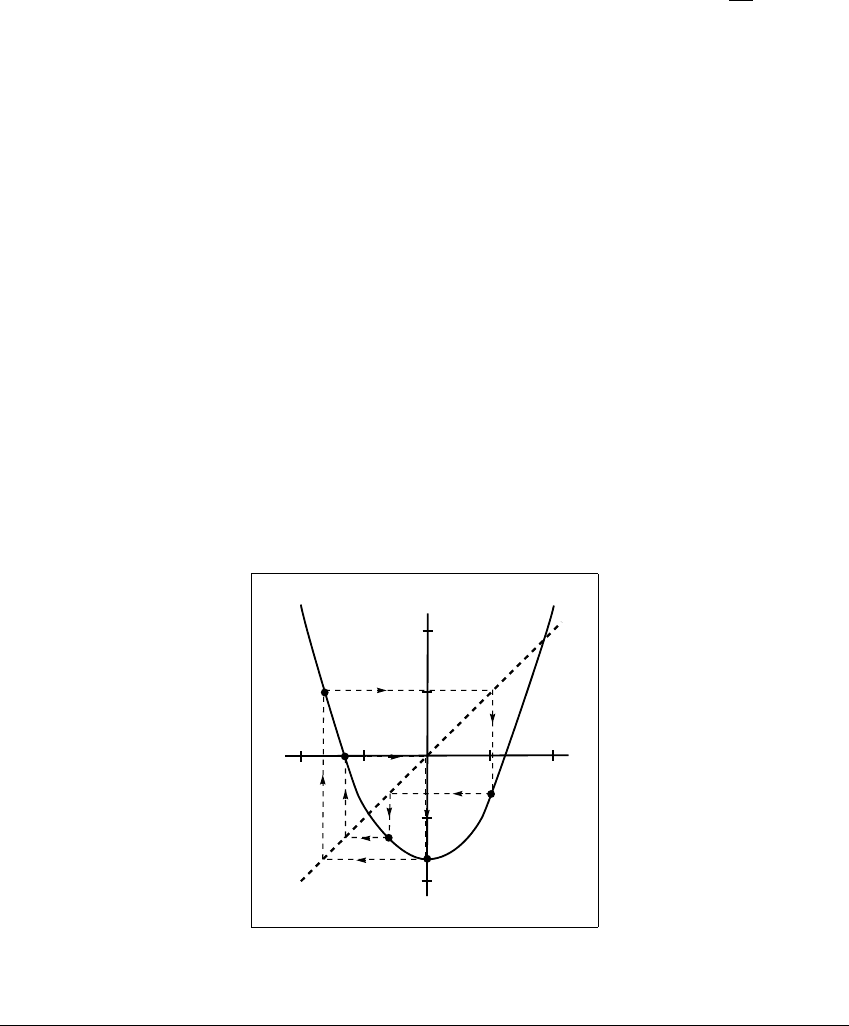Alligood K., Sauer T., Yorke J.A. Chaos: An Introduction to Dynamical Systems
Подождите немного. Документ загружается.


C ASCADES
different types of branches. We may therefore refer to branches as stable (or S)
branches, regular unstable (or U
⫹
) branches, etc.
Definition 12.6 A cascade from period k is a connected set of branches
and bifurcation orbits containing stable branches of period k, 2k, 4k,...,all lying
in a bounded region of parameter and phase space. The connected set will also
contain unstable orbits.
Since we are interested in how chaotic sets develop, we assume Hypotheses
12.7 hold for some closed, bounded region V of phase space. For one-dimensional
maps, V is an interval [x
0
,x
1
], while for two-dimensional maps, V could be chosen
to be a disk. We discuss only orbits all of whose points lie in V.
Hypotheses 12.7 Hypotheses for the Cascade Theorem.
1. There is a parameter value a ⫽ a
0
for which f has only stable fixed points
or stable periodic points. In particular, it may have no periodic points.
2. There is a parameter value a ⫽ a
c
⬎ a
0
(c for “chaotic”) for which f
has unstable periodic points and for which the only periodic orbits are
in U
⫹
or U
⫺
. (Of course, in some cases the order of a
0
and a
c
will be
reversed, but we choose one case to make the discussion simpler.)
3. For a between a
0
and a
c
, the periodic orbits of f all lie in a bounded
region V of phase space. A weaker statement may also be used: there are
no periodic orbits of f on the boundary of the set V.
4. The map f satisfies the Generic Bifurcation Hypotheses of Definition
12.3. In particular, all bifurcations look like those shown in Figures 12.7
and 12.10, and, for each k, there are only finitely many bifurcation orbits
in [a
0
,a
c
] ⫻ V.
In Theorem 12.8, we refer to a connected set of orbits. Thinking of a
period-k orbit as a collection of k periodic points, we mean the connected set of
branches together with endpoints (bifurcation orbits) to which a particular orbit
belongs. For a period-k orbit, there will be k distinct connected sets of periodic
points underlying this one connected set of orbits.
Theorem 12.8 (The Cascade Theorem.) Assume Hypotheses 12.7. Let p
be a regular unstable periodic orbit of f of period k at a ⫽ a
c
. Then p is contained in a
connected set of orbits that contains a cascade from period k. Distinct regular unstable
orbits at a ⫽ a
c
yield distinct cascades: If p
1
and p
2
are two regular unstable orbits at
a ⫽ a
c
, then the two cascades associated with p
1
and p
2
have no branches of stable orbits
in common.
520

12.4 THE C ASCADE T HEOREM
Before going into the proof of Theorem 12.8, we focus again on the type
of situation to which the theorem applies: namely, a one-parameter family of
maps for which at an initial value of the parameter there are no fixed points or
periodic points or only sinks, and at a later parameter value there are only unstable
fixed points or periodic points, such as in a chaotic set. We were introduced to
cascades in the bifurcation diagram of the logistic map (see, for example, Figure
6.3 of Chapter 6). The one-dimensional quadratic family f
a
(x) ⫽ a ⫺ x
2
satisfies
Hypotheses 12.7 for (a, x)in[⫺2, 2] ⫻ [⫺2, 2]. (See Exercise 12.1.) Our primary
two-dimensional example is the formation of a horseshoe in a family of area-
contracting maps. For example, (Devaney and Nitecki,1979) proved that for
fixed b, ⫺1 ⬍ b ⬍ 0, the H
´
enon family H(x, y) ⫽ (a ⫺ x
2
⫹ by, x) develops a
horseshoe as the parameter a is varied. In particular, for a ⬍
⫺(1⫺b)
4
, H has no
fixed or periodic points, and for a ⬎
1
4
(5 ⫹ 2
5)(1 ⫺ b)
2
, a hyperbolic horseshoe
exists. All periodic points and fixed points in this family are contained within a
bounded region of the plane.
The proof of Theorem 12.8 follows from a few key ideas that we split off
as lemmas for you to verify. First we isolate a path of orbits in (a, x)-space within
the possibly vast and interconnected network of orbits that can occur even in
the generic case. The path will enable us to follow cascades even when there are
numerous saddle nodes, period doublings, and period halvings along the path.
Definition 12.9 For any point (a, x) on a periodic orbit that is not a flip
unstable orbit, define the snake through (a, x) to be the collection of S branches
and U
⫹
branches and their endpoints (bifurcation orbits) that can be reached by
a connected path of these branches and their endpoints from (a, x). See Figure
12.12.
✎ E XERCISE T12.6
Verify that a snake passes through an orbit in S, U
⫹
, or a bifurcation orbit
as a one-dimensional path of orbits.
Notice that a snake can be a closed loop of orbits. If it is not, however, then
the snake will never go through any orbit twice. The following lemma says that
under Hypotheses 12.7 regular unstable orbits cannot period double.
Lemma 12.10 When a period-k branch in a snake ends in a period-
doubling bifurcation orbit of period k,thenitisanS branch.
521

C ASCADES
k
2k
k
k
2k
2k
4k
+
+
2k
k
4k
16k
8k
+
2k
...
...
...
k
-
-
-
-
-
-
-
-
a
0
a
1
Figure 12.12 Snakes in a generic bifurcation diagram.
A snake is a connected path of orbits, none of which are flip unstable orbits. Three
snakes are shown in this schematic diagram, which is constructed by eliminating
the flip unstable branches in Figure 12.11.
Lemma 12.10 is proved by observing that it holds for the four cases in
Figure 12.10. Specifically, since the only branches on a snake are S branches and
U
⫹
branches, the period-k branch must be a stable branch. (The fact that there
are no generic period-doublings with U
⫹
branches of period-k follows originally
from the assumption of area-contraction: If one eigenvalue crosses ⫺1atthe
bifurcation point, the other cannot be greater than ⫹1. For one-dimensional
maps, the derivative must move through ⫺1.)
Since snakes are composed only of S and U
⫹
branches, the direction of
travel along a snake (whether a is increasing or decreasing) will change precisely
at a bifurcation orbit, when moving from an S branch to a U
⫹
branch or vice
versa. See Figure 12.12, where S branches are indicated with arrows pointed to
the right, and U
⫹
branches, with arrows pointed to the left. We may say that
a snake enters (or leaves) a region if it has one orbit on the boundary and the
522

12.4 THE C ASCADE T HEOREM
directed path enters (or leaves, according to the direction of arrows) the region
at that orbit.
Lemma 12.11 implies that once a snake enters [a
0
,a
c
] ⫻ V, entering either
from the right at a ⫽ a
c
as a U
⫹
branch, or from the left at a ⫽ a
0
as an S branch,
the snake is trapped inside [a
0
,a
c
] ⫻ V.
Lemma 12.11 No snakes leave [a
0
,a
c
] ⫻ V.
✎ E XERCISE T12.7
Prove Lemma 12.11.
Lemmas 12.12, 12.13, and 12.14 together establish that a snake must con-
tain infinitely many bifurcation orbits, only finitely many of which can be of a
given period N or less. Therefore, the snake must contain bifurcation orbits of
arbitrarily large periods. Since, for a generic family, the only way periods can
increase along a snake is for it to contain period doublings, we obtain the desired
cascade.
Lemma 12.12 Any snake that is not a closed loop of orbits must contain
infinitely many branches and infinitely many bifurcation orbits.
✎ E XERCISE T12.8
Prove Lemma 12.12.
Lemma 12.13 follows from the generic bifurcation hypotheses.
Lemma 12.13 Let N ⬎ 0 be given. A snake contains only finitely many
bifurcation orbits of period N or less for parameter values between a
0
and a
c
.
✎ E XERCISE T12.9
Prove Lemma 12.13.
Lemma 12.14 The snake must pass through bifurcation orbits of periods
k,2k,4k,8k,...,and stable branches of periods k,2k,4k,8k,....
523

C ASCADES
✎ E XERCISE T12.10
Prove Lemma 12.14.
To summarize: Assuming that there are only stable orbits at a
0
and no stable
orbits at a
c
, we have shown that each regular unstable orbit at a
c
must lie on a
connected set of orbits containing a cascade. Generically, an orbit in U
⫹
is born
in a saddle-node bifurcation, paired with an orbit in S of the same period. The
stable orbit then sheds its stability through a period-doubling cascade.
Now we can translate the theorem within an appropriate system. For one-
dimensional families, the stable orbits are attractors, and the unstable orbits are
repellers, either regular or flip. Higher-dimensional systems where orbits have at
most one unstable direction are also appropriate. For families of area-contracting
maps of the plane, the stable orbits are attractors, while the unstable orbits are
saddles, regular or flip.
As a final result, we restate the Theorem 12.8 within this setting.
Theorem 12.15 Let f be a family of area-contracting maps of the plane that
satisfy Hypotheses 12.7, and let p be a regular saddle of f of period k at a ⫽ a
c
. Then p
is contained in a connected set of orbits that contains a cascade from period k. Distinct
saddles at a ⫽ a
c
yield distinct cascades: If p
1
and p
2
are two saddles at a ⫽ a
c
, then the
two cascades associated with these saddles have no branches of attractors in common.
✎ E XERCISE T12.11
Explain which of the arguments in the proof of the Cascade Theorem
depend on the assumption that orbits have at most one unstable direction.
(This assumption underlies the structure of the generic bifurcations.)
We conclude with a brief discussion of moving from the generic to the
general case. In particular, Theorem 12.8 holds for any smooth one-parameter
family f of area-contracting maps of ⺢
2
for which hypotheses (1)–(3) of (12.7)
hold (see (Yorke and Alligood, 1985) for the limit arguments). Families of area-
preserving maps of the plane can also be approximated by maps in our generic
set, although in the area-preserving case, the stable orbits are not attractors but
elliptic orbits. Thus, for families of area-preserving maps of the plane that satisfy
hypotheses (1)–(3) of (12.7), period-doubling cascades of elliptic orbits will occur.
524

C HALLENGE 12
☞ C HALLENGE 12
Universality in Bifurcation Diagrams
T
HE STABILITY ARGUMENTS of this chapter have shown us why period-
doubling cascades must occur in certain systems that develop chaos. Not only
are distinct cascades qualitatively similar, as seen in Figure 12.2, but they also
have metric properties in common, as we saw with Feigenbaum’s discovery for
one-parameter families of one-dimensional maps.
Self-similarity within a cascade follows from the basic idea that higher
iterates of the map can be rescaled in a neighborhood of the critical point to
resemble the original map. For example, Figure 12.13 shows the graphs of iterates
of two maps in the quadratic family g
a
(x) ⫽ x
2
⫺ a. In Figure 12.13(a), g
2
is
graphed for g(x) ⫽ x
2
⫺ 1. At this parameter (a ⫽ 1), the origin is a period-two
point of g, (a fixed point of g
2
). In Figure 12.13(b), g
4
is graphed for g(x) ⫽
x
2
⫺ 1.3107. The origin is a period-four point of g. In each case, the graph in a
-2
-1
0
1
2
-2 -1 0 1 2
-2
-1
0
1
2
-2 -1 0 1 2
(a) (b)
Figure 12.13 Iterates of maps within the quadratic family
g
a
(
x
) ⴝ
x
2
ⴚ
a
.
(a) The origin is a period-two point of g(x) ⫽ x
2
⫺ 1. The second iterate g
2
is
graphed. (b) The origin is a period-four point of g(x) ⫽ x
2
⫺ 1.3107. The fourth
iterate g
4
is graphed. In each case, a neighborhood of the origin in phase space and
of the appropriate a-value in parameter space can be rescaled so that the dynamic
behavior of the iterate in the small scale mimics that of the whole quadratic family
in the large.
525

C ASCADES
neighborhood of the critical point can be rescaled to look like the graph of x
2
⫺ a
at a ⫽ 0. For example, the map g
2
in Figure 12.13(a) would be flipped about the
horizontal axis and rescaled. As a is increased, each parabolic region mimics the
behavior of x
2
⫺ a. Thus sequences of bifurcations, such as cascades, could be
expected to be the same for g
2
a
in a neighborhood of x ⫽ 0anda ⫽ 1 and for g
4
a
in a (still smaller) neighborhood of x ⫽ 0anda ⫽ 1.3107 as for g
a
(x) ⫽ x
2
⫺ a.
In Challenge 12 we examine universal metric properties among different
windows of periodic behavior within chaotic regions of parameter space. The
arguments are given for one-parameter families of scalar unimodal maps, although
the phenomena seems to occur within families of area-contracting planar maps as
well. We show that, typically, the distances between bifurcations (both local and
global) within a periodic window are well-approximated by the corresponding
distances for the canonical map g
a
(x) ⫽ x
2
⫺ a under a suitable linear change of
coordinates. The procedure of rescaling to obtain universal properties is known
as renormalization. Figure 12.14 shows first the complete bifurcation diagram for
the map g
a
(x) followed by a period-nine window for g
9
. The relative distances
between corresponding bifurcations are strikingly similar.
A period-n window begins with a period-n saddle node at a ⫽ a
s
. The stable
period-n orbit then loses stability through a period-doubling cascade, eventually
forming an n-piece chaotic attractor. The window ends at the crisis parameter
Figure 12.14 Universality in periodic windows.
The complete bifurcation diagram for the map g
a
(x) ⫽ x
2
⫺ a is shown above,
while the bifurcations for g
9
a
within a period-nine window are shown below. In the
top diagram, x goes from ⫺2.0to2.0anda is between ⫺0.25 and 2.0, while in
the bottom diagram x goes from ⫺0.02 to 0.02 and a is between 1.5552567 and
1.5554906.
526

C HALLENGE 12
value a ⫽ a
c
at which the n-piece attractor disappears. As with a planar map,
this crisis occurs when the attractor collides with a basin boundary orbit—in this
case, with a period-n source. (See Chapter 10 for a discussion of the planar case.)
The basin of the chaotic attractor includes the union of n disjoint open intervals,
each of which contains a piece of the attractor and one of which contains the
critical point of the map. Since the critical point must map to an endpoint of one
of these intervals, the crisis occurs precisely when the critical point maps onto
one of the period-n boundary sources.
Within a window, we denote the first period-doubling bifurcation parameter
by a ⫽ a
d
. Between the saddle-node at a
s
and the period-doubling at a
d
, the path
of stable period-n orbits must pass through a parameter where the orbit has
derivative 0. At this parameter, denoted a ⫽ a
0
, the orbit is called superstable
and contains a critical point x
0
of the map.
Step 1 Show that the ratio R
g
⫽ (a
c
⫺ a
s
) (a
d
⫺ a
s
)is
9
4
for the period-
one window of the canonical family g
a
(x) ⫽ x
2
⫺ a. [Hint: Find an interval that
maps onto itself to determine a
c
.]
Let k
a
be a family of scalar maps that is linearly conjugate to the canonical
family of maps g
a
. Specifically, define G : ⺢
2
→ ⺢
2
to be (a, x) → (a, g
a
(x)) and
K : ⺢
2
→ ⺢
2
to be (a, x) → (a, k
a
(x)). Then G and K are said to be linearly
conjugate if there is a linear map H : ⺢
2
→ ⺢
2
such that H ◦ K ⫽ G ◦ H. The
form of the linear map we use here is H(a, x) ⫽ (C
1
(a ⫺ a
0
),C
2
(x ⫺ x
0
)), for
nonzero constants C
1
,C
2
.
Step 2 Show that k has a period-n saddle node or period-doubling bi-
furcation at (a, x) or a crisis at a
c
if and only if g has a period-n saddle node or
period-doubling bifurcation at (C
1
(a ⫺ a
0
),C
2
(x ⫺ x
0
)) or a crisis at C
1
(a
c
⫺ a
0
),
respectively.
Conclude for the map k that R
k
⫽ (a
c
⫺ a
s
) (a
d
⫺ a
s
)is
9
4
. Furthermore, any
ratio of distances defined by conditions on periodic points and their derivatives
is preserved under a linear conjugacy.
Now we focus on an arbitrary family f of unimodal maps that has a super-
stable period-n orbit, 兵x
0
,...,x
n⫺1
其,ata ⫽ a
0
. Again, let F(a, x) ⫽ (a, f(a, x)).
We assume that x
0
is the critical point and show that, under certain assumptions,
there is a neighborhood of (a
0
,x
0
) and a linear change of coordinates H for which
HF
n
H
⫺1
is approximated by the canonical family G. The larger n, the period of
the orbit, the closer the approximation, with the distance between them (and
their partial derivatives up to a given order) going to 0 as n goes to infinity. The
527

C ASCADES
ratio R
f
n
in periodic windows for which the hypotheses are well-satisfied is re-
markably close to R
g
⫽ 9 4. We illustrate this correspondence at the end of this
challenge with one of several published numerical studies of the phenomenon.
We say a function k(n)isoforder g, denoted
O(g), if lim
n→
⬁
k(n)
g(n)
is bounded.
For example, n
3
is O(2
n
), but 2
n
is not O(n
3
).
When the orbit of x
0
is superstable, the map f will typically be quadratic near
x
0
, the critical point, and a neighborhood of x
0
will be folded over by f and then
stretched by the next n ⫺ 1 iterates of f before returning close to x
0
. See Figure
12.15. In order to get an intuitive idea of what is happening here, we describe an
idealized f
n
: there is a cycle of n disjoint intervals J
0
,...,J
n⫺1
that the map f
permutes so that f is quadratic on J
0
and linear on the remaining J
i
’s. Specifically,
f
n
(a, x) ⫽ L
n⫺1
⭈⭈⭈L
1
Q(a, x), for constants L
1
,...,L
n⫺1
which, in the ideal
case, do not depend on a, for a quadratic map Q, which depends on both x and a,
and for x 僆 J
0
and a 僆 [a
c
⫺ a
s
]. Notice that under this simplifying assumption
f
n
a
: J
0
→ J
0
is quadratic. Ideally, the parameter extent of the window, a
c
⫺ a
s
,
is sufficiently small that the n ⫺ 1 points in the orbit remain far away from the
critical point and that the constants L
1
,...,L
n⫺1
remain good approximations
to the slopes of f
a
near these points throughout the parameter window.
Let S ⫽
f
n⫺1
x(a
0
,x
1
). (For our idealized map, S is the product of slopes
L
1
⭈⭈⭈L
n⫺1
.) We make the following specific assumptions incorporating the ideas
in the previous paragraph:
2- 2
2
- 2
Figure 12.15 A superstable period-5 orbit.
The map is f(x) ⫽ x
2
⫺ 1.6254.
528

C HALLENGE 12
(1) S grows exponentially with n; that is, there is a constant r, r ⬎ 1, such
that S is
O(r
n
). (This assumption holds if the remaining points in the
orbit, 兵x
1
,...,x
n⫺1
其, are “far” from the critical point. How far, will
determine in part how well the renormalization procedure succeeds in
approximating the canonical map.)
(2) The second partial
2
f
n
x
2
is nonzero at (a
0
,x
0
).
(3) The partial
f
n
a(a
0
,x
0
) is nonzero.
By rescaling both x and a near (a
0
,x
0
), we can make the lowest order terms
in the Taylor series for f
n
match those of the canonical map. The hard part then
is to show that the higher-order terms are made small by the rescaling. We give
a heuristic argument here, based on estimating the order of the error term in
a Taylor expansion of f
n
. More technical estimates including bounds on higher
order partial derivatives can be found in (Hunt, Gallas, Grebogi, and Yorke, 1995).
Step 3 Typically, all the kth order partial derivatives of f
n⫺1
taken with
respect to a and x near (a
0
,x
1
) are of order S
k
. We illustrate this technical point
with an example:
Show that
2
f
n⫺1
x
2
(a
0
,x
1
)isoforderS
2
. [Hint:
f
n⫺1
x
(a
0
,x
1
) ⫽
f
x
(a
0
,x
n⫺1
)
f
x
(a
0
,x
n⫺3
) ...
f
x
(a
0
,x
1
).
Use the product rule (together with the chain rule) to obtain the second partial
derivative.]
Step 4 Using Taylor’s Theorem, verify:
(i) There is a nonzero constant p
1
such that
f
n⫺1
(a, x) ⫺ x
0
⫽ S(x ⫺ x
1
) ⫹ p
1
S(a ⫺ a
0
)
⫹
O(S
2
(|x ⫺ x
1
|
2
⫹ |a ⫺ a
0
|
2
)),
provided |x ⫺ x
1
| and |a ⫺ a
0
| are small compared with S
⫺1
.
(ii) There are nonzero constants q and p
2
such that
f(a, x) ⫺ x
1
⫽ q(x ⫺ x
0
)
2
⫹ p
2
(a ⫺ a
0
)
⫹
O(|x ⫺ x
0
|
3
⫹ |x ⫺ x
0
||a ⫺ a
0
| ⫹ |a ⫺ a
0
|
2
),
for (a, x) near (a
0
,x
0
). Recall that x
1
is f(a
0
,x
0
).
Step 5 Compose (i) and (ii) of Step 4 to obtain
(iii) f
n
(a, x) ⫺ x
0
⫽ qS(x ⫺ x
0
)
2
⫹ pS(a ⫺ a
0
)
⫹
O(S
2
(|x ⫺ x
0
|
4
⫹ |a ⫺ a
0
|
2
))
⫹
O(S(|x ⫺ x
0
|
3
⫹ |x ⫺ x
0
||a ⫺ a
0
|)), (12.2)
529
